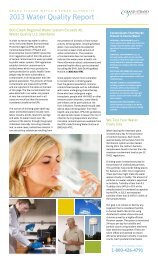Emergency Plan - Grand Strand Water and Sewer Authority
Emergency Plan - Grand Strand Water and Sewer Authority
Emergency Plan - Grand Strand Water and Sewer Authority
Create successful ePaper yourself
Turn your PDF publications into a flip-book with our unique Google optimized e-Paper software.
EVENT SPECIFIC GUIDELINES 14(ESG-14)<br />
HAZARDOUS MATERIAL RELEASE<br />
3.3.4. EMERGENCY PROCEDURES<br />
GENERAL<br />
• Notify <strong>and</strong> evacuate any personnel potentially in danger<br />
• Isolate the area, to prevent others from entering the hazardous area<br />
• If necessary or appropriate, move upwind to a safe area until assistance arrives<br />
• If the releases poses any risk to the general public, advise emergency responders<br />
• All personnel actively involved with an “emergency response” to a release, whether<br />
GSWSA employees or emergency services agencies, must be properly trained, qualified,<br />
<strong>and</strong> equipped – in accordance with OSHA 29 CFR 1910.120.<br />
• Take no action that could jeopardize your safety or that of your co-workers, community,<br />
or the environment.<br />
REPORTING<br />
• All Haz Mat Level 2, 3, or 4 incidents shall be immediately reported to the <strong>Plan</strong>t<br />
Supervisor, Chief of Utility Operations, Director of Fleet, Facilities, <strong>and</strong> <strong>Emergency</strong><br />
Services, <strong>and</strong> Safety Manager.<br />
• All Haz Mat Level 3 or 4 incidents, or any release incident resulting in injury, shall be<br />
promptly reported to the CEO <strong>and</strong> the Chief of Utility Operations.<br />
• Any release potentially affecting the general public shall be immediately reported to the<br />
Horry County Fire Department.<br />
• A chlorine release of 100 pounds or more must be reported to the SARA National<br />
<strong>Emergency</strong> Response Center at 1-800-424-8802.<br />
• A spill that poses a threat to the environment must be reported the Department of Health<br />
<strong>and</strong> Environmental Control (DHEC) at 1-800-555-1212.<br />
SPECIAL CONSIDERATIONS<br />
• Quickly evaluate the wind direction in any release incident. That will dictate what<br />
locations are in danger, <strong>and</strong> what areas are safe.<br />
• Consider the flammability of the spilled / released chemical. Be aware of potential<br />
ignition sources, such as vehicles or equipment operating nearby.<br />
• Be aware of the potential for spilled or leaking chemicals to come in contact with other<br />
chemicals or materials, which may form even more hazardous compounds than the<br />
original chemical, or may result in a violent chemical reaction. For example, HTH, or<br />
dry granulated chlorine, will spontaneously combust (suddenly burst into flames) upon<br />
contact with many petroleum products.<br />
3.3.5. FOLLOW-UP<br />
Safety Manager shall investigate all Haz Mat Level 2, 3, or 4 incidents, <strong>and</strong> shall properly<br />
document <strong>and</strong> follow-up on all findings <strong>and</strong> resulting corrective actions <strong>and</strong>/or<br />
recommendations.<br />
<strong>Gr<strong>and</strong></strong> <strong>Str<strong>and</strong></strong> <strong>Water</strong> & <strong>Sewer</strong> <strong>Authority</strong> 132 CONFIDENTIAL MATERIALS<br />
<strong>Emergency</strong> Management <strong>Plan</strong><br />
SECURITY SENSITIVE<br />
June 7, 2013<br />
NOT FOR PUBLIC DISCLOSURE






